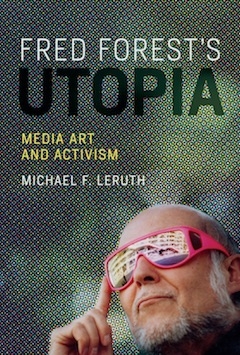by Michael F. Leruth
MIT Press, $29.95/£24.95 (hardcover)
In 1975 Fred Forest turned up to the São Paulo Bienal (in which he had not been invited to take part) in order to stage an alternative biennial of his own. In a hall by the side of the official exhibition galleries, Forest displayed his own photographs, video interviews with Bienal participants and related ephemera as if they were anthropological discoveries from another time entirely. He called it The Biennial of the Year 2000, and the effect was a thoroughgoing estrangement of the whole event, with its quotidian effects and events appearing as curious artefacts from some foreign (future) society.
The stunt was typical of Forest – not just in its playful détournement of artworld rituals, its indeterminate place between public spectacle and public art or its use of video (then, still, an unfamiliar new media) to turn the public gaze back upon itself. But also in the way it positions Forest himself as some vagrant visitor from another time or place. There are moments while reading this often-fascinating monograph when Forest’s antics with Portapaks, telephone systems and TV networks reminds one of that old science fiction trope of the time traveller trapped in the past, desperately trying to marshal the technology of the era in which he finds himself in order to jury-rig the future technology he requires to get home.
Forest’s work has much to tell us about the transformations of time and space wreaked by our contemporary media environment, the slippery nature of reality online and the enduring possibilities for transcendence in a demystified contemporary world
We might recall the Simple Net Art Diagram (1997) by artist group MTAA, in which two simply rendered computer terminals are joined by a snaking black line with a red lightning strike in the centre bearing the caption ‘The art happens here’; Forest’s work, from his first ‘sociological art’ experiments in 1967 to his most recent work in the virtual environment of Second Life, seem to have always taken place in this liminal space between networked terminals.
Fred Forest’s Utopia is a first book for Leruth, the artist’s friend, sometime collaborator and associate professor of French and Francophone studies at the College of William & Mary in the US. It is somewhat dry (though certainly nowhere near the Sahara levels of aridity to be found in much academic writing), but for the most part this doesn’t matter, since Forest’s own antics – inserting blank squares into newspaper front pages, waging highly publicised legal battles against the Centre Pompidou, running for president of Bulgarian state television – are themselves so lively. One might compare Leruth’s text with Stanisław Lem’s dense, fictitious reviews of imaginary books in A Perfect Vacuum (1971) and One Human Minute (1986); indeed, there were times while reading this book when I started to doubt the reality of Forest himself.
Certainly if Forest hadn’t existed, it would have been necessary for someone to invent him. He is, in some ways, the perfect late-twentieth-century artist: born French, but with an American-sounding name; equal parts huckster, prankster and social scientist; marked by the influence of John Cage, Yves Klein, Norbert Wiener and Marshall McLuhan while seeming to anticipate later developments in relational aesthetics and net art. And yet you will search in vain for Forest’s name in Rhizome’s online Net Art Anthology (2016–) or Lauren Cornell and Ed Halter’s anthology of ‘art and the Internet’, Mass Effect (2015). Nor is Forest’s work held in any major national collections – except, significantly, that of the French Institut National de l’Audiovisuel, which is not an art museum but a radio and television archive. The artworld seems constitutively incapable of taking Forest seriously (no doubt his relentless publicity stunts, lawsuits and all round mischief-making haven’t helped).
This is to be regretted, since Forest’s work has much to tell us about the transformations of time and space wreaked by our contemporary media environment, the slippery nature of reality online and the enduring possibilities for transcendence in a demystified contemporary world. While Klein may have introduced the void into contemporary art, Forest, born just five years later, was the void’s first native citizen. Of course he was an old fraud, an egotist and a publicity-seeker. He may also have been the first artist to raise these qualities to the level of the sublime.
From the December 2017 issue of ArtReview
